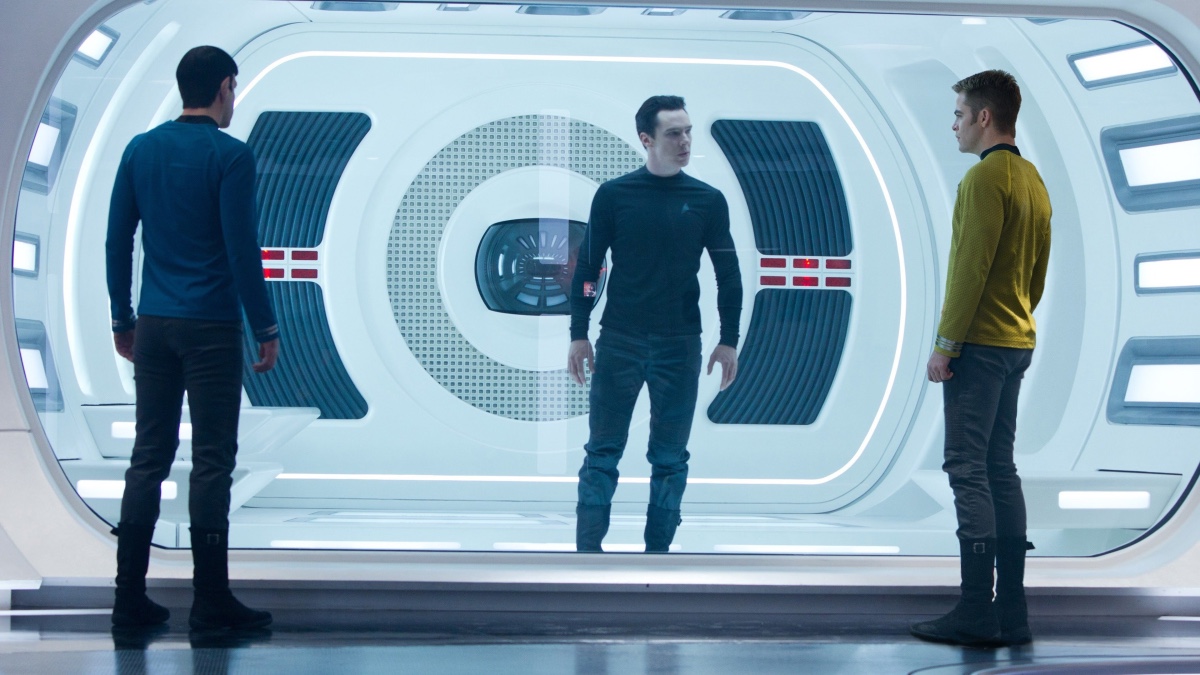Reevaluating ‘Star Trek Into Darkness’ 10 Years Later

We live in a veritable golden age of Star Trek, but as recent as ten years ago, the only Trek content fans were getting on the big or small screen was a movie every few years, if we were lucky. The middle child of JJ Abrams’ Kelvin timeline trilogy, Star Trek Into Darkness was the hotly anticipated sequel to 2009’s Star Trek, a glossy, fresh take that reinvigorated interest in the franchise. When Into Darkness first came along, though, the film didn’t meet quite as friendly of a reception of its predecessor: its decision to reimagine Wrath of Khan’s iconic villain and recreate a number of classic beats from the original Shatner/Nimoy films.
But while it may have taken a (not entirely well-received) gamble in rehashing such a famous part of Trek history, Star Trek Into Darkness is still an ambitious, emotional entry in the franchise that shoulders a sizable legacy without crumbling under its weight.
Starring Chris Pine, Zachary Quinto, and Benedict Cumberbatch, Star Trek Into Darkness follows Kirk and the crew of the Enterprise as they chase a mysterious terrorist (Cumberbatch) after he destroys Starlet headquarters, killing Christopher Pike (Bruce Greenwood) in the process. With mysterious new crew member Carol Wallace (Alice Eve) in tow and a fractured crew questioning his judgement, the film is an intensely personal story for Kirk in particular, who’s forced to grapple with the loss of not just his ship, but his father figure, his crew, and (almost) his closest friend.
Admittedly, when most people think of Into Darkness, the knee-jerk topic of discussion is the way the film reuses the Khan storyline from Wrath of Khan—the classic Trek film that saw Kirk up against a genetically modified superhuman/genius hell-bent on seeking revenge on Kirk for exiling him and his people to a desolate planet. In Wrath of Khan, Kirk and Khan Noonien-Singh have preexisting beef, so the film chronicles his quest for revenge against the Enterprise and her crew. But in Into Darkness, the franchise takes familiar pieces of the formula and rearranges them to create a new, just as emotionally impactful, but fundamentally different story: Instead, it’s now Kirk chasing Khan down for revenge after Khan destroyed Starfleet headquarters/killed Captain Pike.
In swapping the characters’ motives, Star Trek Into Darkness is able to deliver one of the most interesting, unexpected looks at Captain Kirk yet: a vengeful one, driven by anger and hate from the jump. Yes, Kirk delivers that famous “Khannnn!” scream in Wrath of Khan and he’s got plenty of fury there, but that’s at the end of the film, when Kirk is at his lowest moment and thinks Spock is gone for good.
In Into Darkness, Kirk begins the film on a warpath: still young, emotional, and impulsive, he’s warned repeatedly by members of his crew (including Scotty, who recognizes how headstrong Kirk is being and flat-out refuses to serve on the mission, forcing Chekov to step into the role of engineering chief) that going after Khan so suddenly (and with an unknown payload of torpedos) is a bad idea, but he does it anyway.
Part of what makes Chris Pine’s Kirk so endearing and effective is that he has a perpetual youthfulness and a wildcard factor that makes him unpredictable onscreen. Though Kirk is always gutsy across all portrayals, the Kirk we see in Wrath of Khan is aged, experienced, and up against ghosts from his past who’ve come back to haunt him. In Into Darkness, this is a Kirk who still doesn’t have all that much experience in the Captain’s chair, and the death of his mentor, Pike, at the beginning of the film means he’s more lost than ever—and more impulsive.
The switch-up of roles also means we get to see Spock once again engage his emotional, human side—instead of Spock sacrificing himself like in Wrath of Khan, it’s Kirk who ends up dying in front of his first officer, which then prompts Spock to duel Khan one-on-one in a furious attempt at revenge for his seemingly fallen captain.
Yes, the romantic subplot with Uhura continues to feel like it came out of nowhere, but the Kelvin timeline films are consistently excellent in their ability to treat Spock as a proper protagonist in his own right and not just second fiddle/first officer to Kirk. He’s allowed to be emotional and impulsive himself, and combined with the unique time travel hijinks that allow for Quntio!Spock to talk with future/Nimoy!Spock (in Nimoy’s last film role before his passing) Into Darkness is a particularly memorable endeavor for the half-human half-Vulcan XO.
Yes, there are more than a few aspects of the film that don’t work. Though the Carol Marcus subplot is interesting, the film’s blatant over-sexualization of her character feels like an outdated remnant of the show’s ’60s sensibilities that should’ve stayed in the past. Cumberbatch, too, doesn’t quite measure up to the borderline suave wit of Ricardo Montalbán’s original performance as Khan, which just made the main problem with the casting—the whitewashing—even worse. His icy, stoic take on the character is commendable in the sense that it’s not simply ripping off what made the character so popular in the first place, but it was doomed from the start.
But while it may not be perfect, Star Trek Into Darkness is still a solid, often surprisingly gutsy approach to the franchise, taking familiar archetypes and using them to push an alternate timeline set of characters we know and love into unique emotional places they’ve never previously explored. Between the revamped Khan twist, the reversal in the Kirk/Spock death scene, and the pulse-pounding, well-paced action, Star Trek Into Darkness deserves its flowers ten years on from its original theatrical release.
(featured image: Paramount)
Have a tip we should know? [email protected]